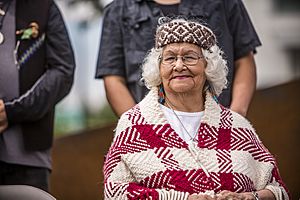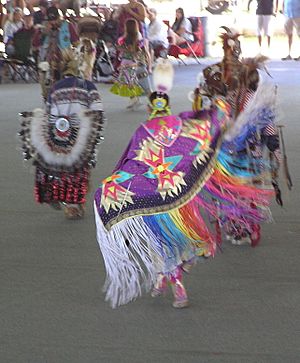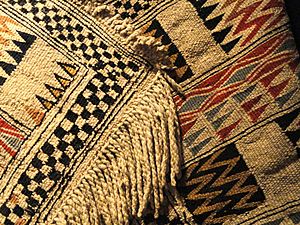Salish peoples facts for kids
| Séliš | |
|---|---|

Squamish elder Audrey Rivers wearing wool regalia at a Pole Raising Ceremony (July 2012).
|
|
| Regions with significant populations | |
| British Columbia, Washington, Oregon, Idaho, Montana | |
| Languages | |
| Salishan languages | |
| Related ethnic groups | |
| Indigenous peoples of the Pacific Northwest Coast |
The Salish peoples are Native American groups. They live in the Pacific Northwest region of America and Canada. These groups are known for speaking languages from the Salish language family. These languages began to develop between 3,000 and 6,000 years ago.
The name "Salish" was created more recently. It came from the word "Séliš," which is what the Salish Tribes of the Flathead Reservation called themselves. Since these tribes were the first Salish people to work with the United States government, their name was later used for all groups speaking similar languages.
Contents
Salish Languages and Culture
The Salish people are divided into four main groups. These are the Bella Coola (Nuxalk), Coast Salish, Interior Salish, and Tsamosan. Each group speaks a different Salish language. The Tsamosan group is often considered part of the larger Coast Salish peoples.
There are twenty-three known Salish languages. Sadly, at least five of these languages are no longer spoken. The others are in danger of disappearing. Most people who speak Salish languages fluently are older adults. It is rare to find young people who speak them.
However, many groups are working hard to keep these languages alive. They have special programs to teach and revive them. Scholars are also studying the languages. They create learning materials and resources for future generations.
Keeping Languages Alive
Salish languages, especially those spoken by Coast Salish peoples, face challenges. A big reason for this is assimilation. For example, Canadian residential schools used to forbid Indigenous languages. This greatly reduced the number of fluent Salish speakers.
Today, schools from high school to university are helping. They actively teach and promote the use of Salish languages. This helps new generations learn and connect with their heritage.
Taking Back Their Culture
In 1988, the Confederated Salish and Kootenai Tribes (CSKT) started a project. It helped them gain more control over their own affairs. By 1993, the U.S. government gave them full independence.
Over the years, the CSKT returned to their traditional ways of governing. Elders now advise the chief on important matters. These include tribal policies, culture, and education. This has helped strengthen the community's connection to its heritage.
In 2016, the tribe changed its name. They went from "Salish-Prend d’Oreille" to Séliš-Ql̓ispé. This was part of a bigger effort to use more Salishan language in daily life. It also helped them push back against past policies that tried to make them change their ways.
For the Séliš-Ql̓ispé, language and culture are deeply connected. They believe that by bringing back their language, they can also reclaim their identity, health, and traditions.
Community Efforts
Many community efforts help keep Salishan language and culture strong. Some groups offer language classes. These can even be full-immersion programs. This means students only speak Salish, with no English.
Other efforts include virtual tours and museums. For example, the Sq'éwlets is a Stó:lō-Coast Salish community. They offer online tours of their history. The People's Center Museum opened in 1994. It shows Salish and Kootenai cultural items. The museum also shares oral stories. These stories explain the meaning of the items. They tell about the people who lived long ago.
There are also calls for the return of artifacts. Many Indigenous tribes want their historical items back. This is another way to reclaim their history and culture.
Powwows and Celebrations
The Arlee Espapqeyni Celebration is a yearly powwow. It is hosted by the Confederated Salish and Kootenai Tribes. It takes place in Arlee, Montana, around July 4th. The event lasts several days. It includes dance and singing competitions. There are also non-competitive singing and drum performances.
In 1884, the Bureau of Indian Affairs (BIA) made it illegal for Native Americans to perform their dances. So, tribes danced in secret. A new dance, called the Ghost Dance, began to spread. The U.S. government worried about its popularity. In 1890, soldiers were sent to Wounded Knee. They interrupted a Ghost Dance ceremony among the Sioux. About 200 Sioux people were killed in what is now known as the Wounded Knee Massacre.
Modern powwows started after World War I. Native American veterans returned home from the war. Celebrations were held to welcome them. These included traditional dances. A new sense of community grew. Nearby reservations began to include each other in their celebrations. This made powwows bigger and more inclusive.
After World War II, the U.S. government moved many Plains Indians to cities. Their culture and traditions spread with them. This is why many powwow dances and songs come from the Plains tradition. This movement of people also made the connections between tribes stronger.
Salish Art and Culture
Salish Weaving
Salish weavers used both plants and animal fibers. Coast Salish people kept special woolly dogs. They bred these dogs for their soft wool. This wool was spun into yarn for weaving.
Coast Salish weavers also used mountain goat wool. They used waterfowl down and plant fibers too. These included cedar bark, nettle fiber, milkweed, and hemp. They would mix these materials in their weaving. Sometimes, white clay was pounded into the fibers. This might have helped remove oil from the wool.
Not all Salish blankets were made with dog wool. Blankets for everyday people were often made from plant fibers. Salish weaving designs often featured geometric patterns. These included zig-zags, diamonds, squares, rectangles, V-shapes, and chevrons.
In the 1800s, the fur trade brought Hudson's Bay blankets to the Pacific Northwest. These machine-made blankets were cheaper. This led to a decline in native wool blankets. These traditional blankets were expensive and took a lot of work to make.
Salish weaving continued, but less often. Weavers started using sheep's wool yarn. Traders brought this yarn to the area. It was cheaper than raising woolly dogs, which ate a lot of salmon.
A revival of Salish weaving began in the 1960s. The Salish Weavers Guild was formed in 1971.
Using Cedar Wood
The Western Red Cedar tree is common in the Pacific Northwest. It was a very important resource for Coast Salish peoples. They used cedar for many things. Canoes, longhouses, totem poles, baskets, and mats were all made from cedar. They even made clothing from its fibers.
Totem Poles
Totem poles were not as common in Coast Salish culture. Neighboring non-Salish groups, like the Haida and Tlingit, used them more. It was not until the 1900s that northern Coast Salish peoples adopted the tradition. These included the Cowichan, Comox, and Lummi tribes.
These tribes made fewer free-standing totem poles. Instead, they were known for carving house posts. These posts were placed inside and outside their longhouses.
-
Salish wooden carvings at The Field Museum, Chicago
-
Totem pole by Lummi carver Joe Hillaire, 1962
Salish peoples in the Pacific Northwest and parts of Southern Alaska built totem poles. These poles often showed a tribe member's spirit animal or family crest. Today, they continue this tradition. They sell hand-carved totem poles made in the same style.
Modern Salish Artists
Many talented Salish artists create amazing work today:
- Susan A. Point is a Musqueam artist. She carves wood and works with glass. Her art, "Musqueam Welcome Figures," is at the Vancouver International Airport. It is inspired by old Coast Salish house posts.
- Matika Wilbur is a Swinomish and Tulalip photographer. She created Project 562. This project takes pictures of modern Native Americans from all 562 federally-recognized tribes in the United States.
- Debra Sparrow is a Musqueam artist and weaver. Her weaving was shown in a special exhibit. It was called "The Fabric of Our Land: Salish Weaving." This exhibit was at the Museum of Anthropology in 2017-2018.
- Corwin Clairmont is a Salish Kootenai artist. He makes prints, and also creates conceptual and installation art.
Salish Groups and Where They Live
Salish people are grouped by their language families. These include the Coast Salish, Interior Salish, and the Nuxalk (Bella Coola) people.
The Nuxalk are the northernmost Salish people. They live around Bella Coola, British Columbia. This area is separate from where most other Salish peoples live.
Below is a list of many Salish tribes and bands, from north to south.
Coast Salish Peoples
- Chehalis
- Comox
- Cowlitz
- Cowichan
- Halkomelem-speaking peoples
- Homalco (Xwemalhkwu)
- Klahoose
- Klallam
- Lushootseed-speaking peoples
- Lummi
- Musqueam
- Nooksack
- Pentlatch
- Puyallup
- Quinault
- Saanich
- Shishalh (Sechelt or Shíshálh)
- Skokomish (Twana)
- Squamish
- Tillamook
- Sliammon (Tla A'min)
- Tsleil-Waututh
- T'Sou-ke
Interior Salish Peoples
- Northern
- Secwepemc (Shuswap)
- St'at'imc (Lillooet)
- Nlaka'pamux (Thompson River people)
- Southern
- Okanagan-speaking peoples
- Entiat
- Wenatchi
- Sinkiuse-Columbia
- Chelan people
- Spokane people
- Confederated Salish and Kootenai Tribes (Flathead)
- Coeur d'Alene people
See also










